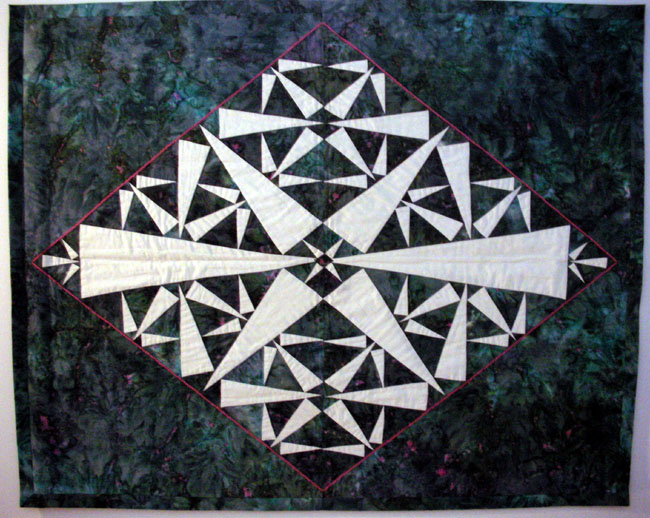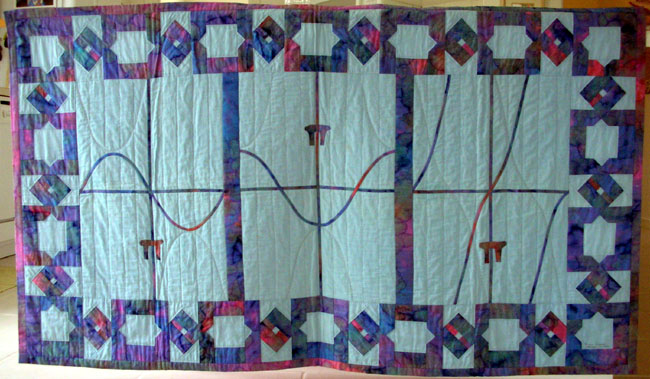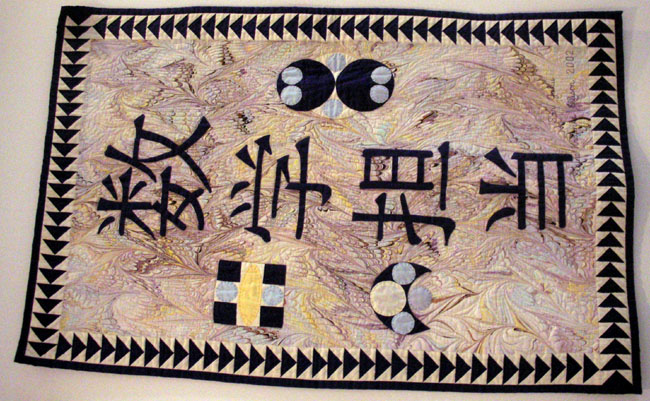Elaine Krajenke Ellison
"Orthic Triangles - A Tribute to Douglas Hofstadter"
Quilt out of 100% cotton, 39" X 47", 2001.

While attending a class that Dr. Hofstadter taught at Indiana University, I
found the top half of this quilt of interest. Dr. Hofstadter was illustrating
what would happen if we began with an isosceles triangle with only two congruent
sides, and then dropped altitudes from each vertex of the triangle. The repetition
of this pattern began to generate half of this quilt. Due to the restrictions
of the cloth, only a few of the triangles were sewn.
"Koch Curve"
Quilt out of 100% cotton, 30" X 30", 2000.

I began to learn about fractals from Jon Choate at an Exeter Conference. I knew
that my students would enjoy learning about a new kind of geometry that was
relatively new. My high school did not have an entire class devoted to fractals,
so I would integrate fractals like the Koch Curve whenever I could. My students
found the topic fascinating and fun!
"Spiraling Pythagorean Triples"
Quilt out of 100% cotton, 36" X 36", 1987.

The pattern for the 3-4-5, 5-12-13, 7-24-25, 9-40-41, and 11-60-61 all are found
in this quilt! The design is not original and I can't recall where I found the
design. It was incredible to me that these triples would "fit" together in such
an interesting pattern. This quilt hung at the front of my classroom as a reminder
of the importance of the triples.
"The Six Trigonometric Functions"
Quilt out of 100% cotton, 35" X 60", 2000.

Students enjoyed having a "visual" guide to the six trigonometric functions hanging in the classroom. We generated each of the curves by hand-and that gave the students hands-on experience as to why the curves look like they do. Around the quilt we find Moorish mosaics from the Palace of Don Pedro from the Alcazar. Between the mathematics and the tiles, this quilt is truly a multi-cultural work of art.
"San Gaku - Su Gaku Tanto - (translated: I am a Mathematics Teacher)"
Quilt out of 100% cotton, 25" X 39", 2002.

It was a pleasure researching the tablets of the Edo Period - 1603-1867 in Japan. The tablets are found in Shinto Shrines and Budhist Temples. Only about 800 tablets still exist in a variety of place in Japan. The solving of the problems on the tablets was a way of venerating the Gods. As a teacher I was able to tie in the mystical part of mathematics as it developed around the world. Even though Japan was cut off from the western world at this time, I found similarities amongst the patterns in the San Gaku and western mathematics.
Elaine Krajenke Ellison
Retired high school mathematics teacher, retired high school mathematics methods teacher
West Lafayette High School, Purdue University
eellisonelaine@yahoo.com
www.mathematicalquilts.com
"Mission: The appreciation and demystification of mathematics is a common thread that runs through my mathematical art. After using a variety of media including bronze, drawing, glass, and painting, I settled on quilts in the early l980's. The quilts serve as a visual introduction that allow students to explore mathematics as they gain more insights. As the number of quilts increased each year, I was able to write lesson plans for the quilts. The quilt topics were based on what topics I was teaching at the time-mostly geometry and algebra. From this beginning, Mathematical Quilts and More Mathematical Quilts was published. Since this beginning, I have been able to share my love of mathematics with quilt groups, mathematics groups, museums, and various other interested groups. I am hoping to meet some of the mathematicians that have inspired me over the years at this conference."